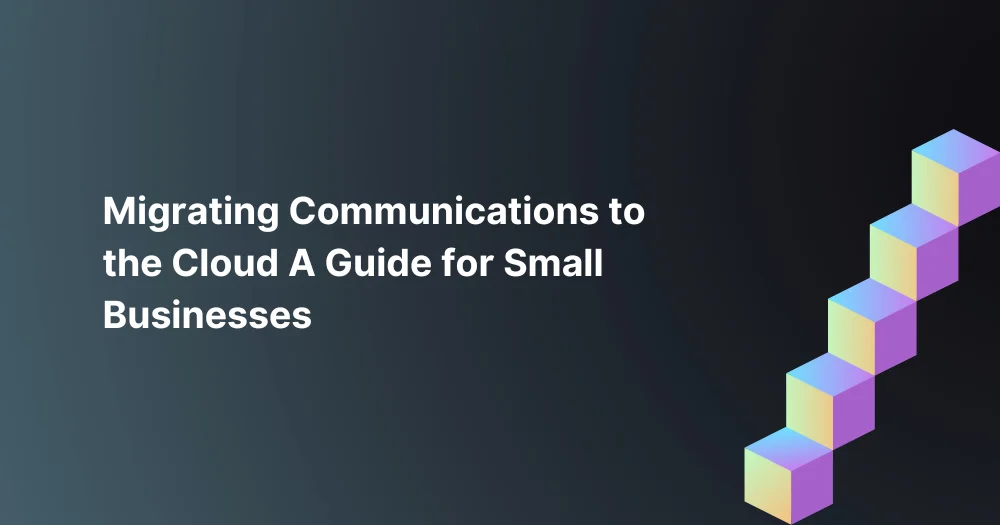
Technology has become embedded in our lives, and forward-thinking businesses recognize cloud computing’s potential to transform their communications. From streamlined collaboration to scalable solutions, cloud-based communication systems transform how companies connect with their customers, partners, and team members. Boasting effective, secure, and affordable solutions, it is unsurprising that many companies are migrating to the cloud.
This article will explore everything businesses need to know about migrating their communications to the cloud.
Businesses can take advantage of a plethora of cloud communication solutions, such as VoIP telephone systems, messaging and chat applications, and video conferencing tools—all designed to facilitate an effortless connection between teams.
VoIP phone systems are the perfect modern solution for businesses, allowing them to make and receive calls over the Internet instead of using regular telephone networks. This technology can be used with hard phones, softphones, or mobile devices, making it useful for remote workers or those who travel frequently. VoIP phone systems are convenient and highly cost-effective for businesses. Their price points typically come in much lower than traditional phone systems.
Messaging and chat platforms such as Slack and Microsoft Teams facilitate instantaneous communication and collaboration between teams, regardless of location. These platforms offer file-sharing features, video and voice chat, and project management tools to streamline communication and collaboration.
Video conferencing tools like Zoom and Teams allow businesses virtual face-to-face meetings with clients, partners, and remote teams. These platforms provide accessible features such as screen sharing, powerful Q&A functionality, and webinar hosting capabilities.
Taking the plunge to migrate your communications systems into the cloud is a big decision. Still, there are effective strategies businesses can take to ensure an effortless and successful transition.
Overall, migrating communications to the cloud can be a complex process that requires thorough planning and execution. However, with the right approach and resources, businesses can successfully migrate their communications to the cloud and enjoy its benefits.
To gain insights into the risks accompanying transitioning communications to the cloud, let’s examine these potential issues and disadvantages in greater detail.
When choosing a cloud communication provider, take security into account. A major worry for businesses as they transition their communication to the cloud, is safeguarding their data from potential attackers. Consider incorporating two-factor authentication and end-to-end encryption to guarantee data privacy and security. These technologies are easy to implement and offer robust protection from potential threats.
Businesses must have a data backup and recovery plan to protect against unforeseen equipment or software failures. Regularly backing up data is essential for keeping your business safe from potentially costly losses. It’s also important to know how to protect sensitive data.
Businesses should also be aware that many cloud communication providers offer their security options. For example, some providers offer enterprise-level antivirus protection against phishing and malware.
To make a successful shift to the cloud, it is essential that your team quickly learn how to use the new communication tools. Although this requires effort and time, investing in staff development will ensure a seamless transition.
Staff training and support should be included in your migration plan. Ensure that you provide adequate time and resources to equip your team with all the knowledge they need with the new technology. It can also help appoint super-users who can provide on-the-job training and support their peers.
It’s important to create a culture of digital communication. This means embracing digital communication platforms and using them effectively while maintaining a personal connection with colleagues and customers.
Businesses migrating to the cloud should consider the total cost of ownership of their communication platform. Organizational costs go beyond initial investments in hardware, software, and maintenance fees. Additional expenses might be incurred if you add new features or expand capabilities.
To avoid cloud communication mistakes, prepare a budget plan that accounts for all the relevant cost factors. With this, you can be confident that the transition will be cost-effective and sustainable for years.
Businesses can easily stay ahead of the quickly-evolving technological landscape by using cloud-based communication tools, boosting their productivity and efficiency. With proper planning, training, and support throughout the migration process, transitioning to these reliable solutions is a surefire way for your business to succeed tremendously.
By following the tips outlined in the blog and speaking to cloud migration consultants, businesses can confidently transition to the cloud.
For businesses considering migrating to the cloud, BlackPoint IT offers a range of VoIP solutions designed to meet specific requirements. Our team of experts provides support throughout the entire process, helping to plan and execute a smooth transition to the cloud with minimal to zero business interruptions. Contact us today to know how we can make the switch to the cloud a breeze for your business.